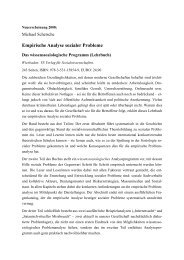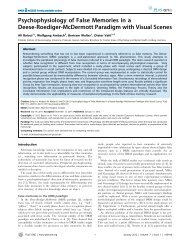2 Projects and Results - IGPP
2 Projects and Results - IGPP
2 Projects and Results - IGPP
Create successful ePaper yourself
Turn your PDF publications into a flip-book with our unique Google optimized e-Paper software.
Theorie und Datenanalyse 1<br />
2 <strong>Projects</strong> <strong>and</strong> <strong>Results</strong><br />
2.1 Theory <strong>and</strong> Data Analysis<br />
The main research activities of the Department of Theory<br />
<strong>and</strong> Data Analysis are the analysis <strong>and</strong> interpretation of the<br />
empirical body of knowledge referring to psychophysical<br />
relations <strong>and</strong> extraordinary states of consciousness. In particular,<br />
this refers to:<br />
1. Development of theoretical concepts for an integration<br />
of empirical results into the body of knowledge of the involved<br />
scientific disciplines.<br />
2. Elaboration <strong>and</strong> application of new techniques of data<br />
analysis as well as proposals for future studies.<br />
Specific research topics within this program require highly<br />
interdisciplinary approaches <strong>and</strong> have been successfully established<br />
<strong>and</strong> evaluated since the foundation of the department<br />
in 1998. They are anchored in the four research areas<br />
described in the following <strong>and</strong> involve background in statistics<br />
<strong>and</strong> data analysis, theoretical physics, cognitive neuroscience,<br />
<strong>and</strong> philosophy of science.<br />
2.1.1 Concepts of Mind-Matter Relations<br />
Contextual Emergence<br />
Contextual emergence characterizes a specific kind of relationship<br />
between different levels of scientific descriptions<br />
of particular phenomena. It was developed <strong>and</strong> refined in<br />
collaborations within <strong>and</strong> outside the department, essentially<br />
since 2002. Contextual emergence utilizes lowerlevel<br />
(L) features as necessary (but not sufficient) conditions<br />
for the description of higher-level (H) features. It can<br />
be viably combined with the idea of multiple realization, a<br />
key issue in supervenience, posing sufficient (but not necessary)<br />
conditions at the lower level. In scientific areas such<br />
as physics, contextual emergence has been demonstrated as<br />
a formally precise <strong>and</strong> straightforwardly applicable interlevel<br />
relation. The situation becomes more challenging for<br />
less rigorously formalized fields of research. This is the<br />
case in the areas of cognitive neuroscience or consciousness<br />
studies, focusing at relations between neural <strong>and</strong> mental<br />
states.<br />
Atmanspacher; together with Bishop, beim Graben<br />
Publication: Atmanspacher (2009a)<br />
Mental States from Neurodynamics<br />
In recent theoretical work we showed how contextual emergence<br />
is to be understood in detail. The basic idea is that,<br />
starting at a particular neural level L of description, a twostep<br />
procedure can be carried out that leads (1) from an individual<br />
neural description L i to a statistical neural description<br />
L s <strong>and</strong> (2) from L s to an individual mental description<br />
H i . The essential goal of step (1) is to identify a partition<br />
consisting of equivalence classes of individual neural<br />
states, representing the multiple realizability of statistical<br />
neural states in L s . The essential goal of step (2) is to assign<br />
individual mental states at level H to statistical neural<br />
states at level L. This is impossible without a context at<br />
H defining the set of observables at level H that is to be<br />
constructed from L s . This context can be implemented as a<br />
stability criterion at level L.<br />
It has been demonstrated how this procedure works for experimental<br />
data from cognitive neuroscience. For this purpose<br />
we used data from the EEG of subjects with sporadic<br />
epileptic seizures. The analytic procedure starts with the<br />
construction of a (Markov) transition matrix reflecting the<br />
EEG dynamics in the neural state space. The eigenvalues of<br />
this matrix yield time scales defining partitions of increasing<br />
refinement that can be used for the assignment of mental<br />
states. The result of the partitioning can be inspected<br />
in the originally recorded time series. This comparison of<br />
obtained mental states with corresponding episodes in the<br />
EEG dynamics showed perfect agreement between the distinction<br />
of normal <strong>and</strong> epileptic states <strong>and</strong> the bipartition<br />
resulting from the spectral analysis of the neural transition<br />
matrix.<br />
Atmanspacher; together with Allefeld, beim Graben, Wackermann<br />
Publications: Atmanspacher (2009a), Allefeld, Atmanspacher,<br />
Wackermann (2009)<br />
Alternative Similar Approaches<br />
Contextual emergence addresses the construction of a partition<br />
at a lower-level description by a higher-level context<br />
which adapts this partition to a specific higher-level description.<br />
An alternative strategy was proposed by Amari<br />
<strong>and</strong> colleagues in the 1970s to construct neural macrostates<br />
from neural microstates. They identified neural macrostates<br />
based on two criteria: (i) the structural stability of microstates<br />
as a necessary lower-level condition, <strong>and</strong> (ii) the<br />
decorrelation of microstates as a sufficient condition induced<br />
by the higher level. These criteria, however, do not<br />
exploit the dynamics of the system in the direct way which<br />
a Markov partition allows. A detailed study of the way in<br />
which contextual emergence appears in Amari’s approach<br />
was finished. Moreover, Tononi’s ambitious program of an<br />
“information integration theory” shares important features<br />
with contextual emergence which we have started to investigate.<br />
Atmanspacher; together with Barrett, beim Graben<br />
Publications: Atmanspacher (2009a), beim Graben, Barrett,<br />
Atmanspacher (2009)<br />
Causal Closure <strong>and</strong> Overdetermination<br />
Many debates of mental influences on brain processes are<br />
based on the assumption of the “causal closure of the physical”.<br />
Briefly, this means that effects on physical states<br />
can only be caused by (previous) physical states. A detailed<br />
look at the notions involved shows that the causal<br />
closure assumption depends on time symmetries inherent in<br />
the fundamental physical equations of motion. Their solution<br />
always requires a specification of initial/boundary conditions<br />
<strong>and</strong> implies a breakdown of time symmetries due<br />
to the action of an experimenter or observer. This general<br />
objection against the causal closure of physical states is independent<br />
of the system considered.<br />
In the philosophy of mind, the argument of overdetermination<br />
is often used against the causal efficacy of mental states
2 Theory <strong>and</strong> Data Analysis<br />
on neural states. If neural states are described as effects of<br />
previous neural states, then an additional mental influence<br />
(mental causation) “overdetermines” the neural states. This<br />
can lead to severe inconsistencies which can be avoided if<br />
mental states are well-defined on the basis of proper partitions<br />
of the underlying neural state space. This entails a<br />
correlational balance of mental <strong>and</strong> neural states which, according<br />
to the interlevel relation of contextual emergence,<br />
respects both neural <strong>and</strong> mental features.<br />
Atmanspacher; together with Bishop, Harbecke<br />
Panexperientialism in Dual-Aspect Models<br />
Following up on a proposal by Primas, we studied the possibility<br />
to translate the mind-matter distinction into terms<br />
of mental <strong>and</strong> physical time. In the spirit of this idea,<br />
we hypothesized a relation between the intensity of mental<br />
presence <strong>and</strong> a time scale (some seconds) often referred<br />
to as a measure for the duration of nowness. This duration<br />
is experimentally accessible <strong>and</strong> might offer a suitable<br />
way to characterize the intensity of mental presence. Some<br />
features consistent with other, related ideas have been indicated<br />
<strong>and</strong> interesting consequences with respect to the<br />
idea of a generalized notion of mental presence, with human<br />
consciousness as a special case, have been outlined. In<br />
particular, the phenomenal experience of nowness can be<br />
regarded as a fundamental quale, thus providing a concrete<br />
option, to be explored in more detail, to address the idea of<br />
panexperientialism.<br />
Atmanspacher; together with Franck<br />
Publication: Franck, Atmanspacher (2008)<br />
Riemann’s Philosophical Speculations<br />
Posthumously edited fragments of the distinguished mathematician<br />
Bernhard Riemann (1826–1866) document his<br />
attempts to integrate physical <strong>and</strong> mental phenomena in a<br />
universal framework. For this purpose Riemann adopted<br />
a basic idea of the philosopher Herbart (1776–1841) who<br />
conceived of science as the “reworking of concepts”. One<br />
goal of this project was to outline Riemann’s sketchy <strong>and</strong><br />
often amazing speculations in their full breadth. Emphasis<br />
is put on the idea that Riemann may have sought the<br />
link between the material <strong>and</strong> the mental in the notion of<br />
an “agens”, wherein the concepts of state <strong>and</strong> change converge.<br />
The interaction between Riemann <strong>and</strong> Herbart can<br />
serve as a case in point for the impact of philosophy on the<br />
development of science in the 19th century.<br />
Ehm<br />
Journal “Mind <strong>and</strong> Matter”<br />
The journal “Mind <strong>and</strong> Matter” was established in 2003 <strong>and</strong><br />
has received increasing visibility as a medium for questions<br />
of mind-matter research since then. The journal appears<br />
semi-annually, <strong>and</strong> the contents of all issues published so<br />
far can be found at www.mindmatter.de. The number<br />
of submissions grows continuously, the current aceptance<br />
rate is about 35%. Since 2005 the journal has been produced<br />
<strong>and</strong> distributed by Imprint Academic, Exeter (UK);<br />
the editorial office has remained in the h<strong>and</strong>s of the <strong>IGPP</strong><br />
theory group. The themes of the 2008 <strong>and</strong> 2009 issues were<br />
“Psychophysics: Puzzles <strong>and</strong> Prospects”, “Consciousness<br />
Across Cultures”, Free Will: Foundational Frameworks”,<br />
<strong>and</strong> “Expounding Emotions”.<br />
Atmanspacher, Moos<br />
Publications: Atmanspacher, ed., Mind <strong>and</strong> Matter 6(1),<br />
6(2), 7(1), 7(2)<br />
2.1.2 Generalized Quantum Theory<br />
Quantum theory contains two key concepts, complementarity<br />
<strong>and</strong> entanglement, that are often metaphorically applied<br />
to situations beyond physics. In 2002 we proposed<br />
an axiomatically formalized, generalized quantum theory to<br />
make such applications more rigorous. The crucial formal<br />
criterion leading to complementarity <strong>and</strong> entanglement is<br />
the non-commutativity of particular observables of the system<br />
considered. The ordinary Hilbert space quantum mechanics<br />
can be recovered by stepwise adding the necessary<br />
features. This provides a hierarchy of formal frameworks<br />
of decreasing generality <strong>and</strong> increasing specificity.<br />
Recently we started to work out more refined accounts of<br />
the notion of observables versus operations, of the distinction<br />
between ontic <strong>and</strong> epistemic states, <strong>and</strong> the consequences<br />
of these distinctions for Bell-type inequalitities.<br />
An earlier survey paper on generalized quantum theory was<br />
translated into French, <strong>and</strong> two articles accessible for nonexperts<br />
have been published as well.<br />
Atmanspacher, Filk; together with Römer<br />
Publication: Atmanspacher, Filk, Römer (2009), Atmanspacher<br />
(2009d), Atmanspacher (in press)<br />
Non-Commutative Operations in Psychology<br />
Non-commutativity, hence complementarity, plays a significant<br />
role in many situations in psychology. In simple<br />
words this means that the result of successive operations A<br />
<strong>and</strong> B depends on their sequence. This is to be expected if<br />
measurement operations are conceived as interactions between<br />
measuring <strong>and</strong> measured system rather than mappings<br />
from measured to measuring system. Such interactive<br />
measurement operations can be formalized by multiplicative<br />
sets of operators which do not commute with each<br />
other, AB ≠ BA. Pertinent examples are: (i) processes<br />
involved in the perception of bistable stimuli, <strong>and</strong> (ii) processes<br />
involved in learning operations in (small) networks.<br />
An additional topic that we started to study refers to context<br />
effects in questionnaires, indicating that the sequence<br />
of questions may be crucial for the responses.<br />
Atmanspacher, Filk; together with Römer<br />
Complementarity of Mental Descriptions<br />
Descriptions of mental states <strong>and</strong> their dynamics are incompatible,<br />
or even complementary, if they are based on an improper<br />
partition of the underlying neural state space. Compatible<br />
descriptions at the psychological level, which are<br />
topologically equivalent, i.e. consistent, with the underlying<br />
neurobiological description, emerge only if the mental<br />
states defined at the psychological level are dynamically<br />
stable. If the neural dynamics is sufficiently complex,
Theorie und Datenanalyse 3<br />
e.g. chaotic, this requires that the partition providing these<br />
states be generating (or, more specifically, Markov). Generating<br />
partitions are defined by the dynamics of the neural<br />
states <strong>and</strong> give rise to particular, dynamically stable equivalence<br />
classes of neural states that can be re-defined symbolically<br />
as mental states. As a consequence, we suggest<br />
that the program of a unified science of psychology, with<br />
mutually compatible domains of description, depends on a<br />
proper choice of partitions of the neural state space.<br />
Atmanspacher; together with beim Graben<br />
Publication: beim Graben, Atmanspacher (2008)<br />
Necker-Zeno Model for Bistable Perception<br />
The Necker-Zeno model for bistable perception, inspired<br />
by the quantum Zeno effect, was previously used to relate<br />
basic time scales of cognitive relevance to one another in<br />
a quantitative manner. The model predictions have been<br />
compared with experimental results obtained under continuous<br />
<strong>and</strong> discontinuous presentation of ambiguous stimuli.<br />
In addition to earlier results of increasing “dwell times” (inverse<br />
reversal rates) for increasing <strong>and</strong> long inter-stimulus<br />
intervals, we have shown that the reversal dynamics according<br />
to the Necker-Zeno model is also in agreement with new<br />
observations for increasing dwell times for decreasing <strong>and</strong><br />
short inter-stimulus intervals.<br />
These results are non-trivial since they represent opposing<br />
trends for long <strong>and</strong> short inter-stimulus intervals, separated<br />
by a critical time scale of the order of 300 msec. Moreover,<br />
the model accounts for the experimentally observed<br />
distribution of dwell times <strong>and</strong> permits an experimental distinction<br />
between different attentional effects. The Necker-<br />
Zeno model also suggests modifications of cognitive time<br />
scales under conditions of psychopathological impairments<br />
<strong>and</strong> meditation-induced modes of awareness.<br />
Atmanspacher, Filk, Kornmeier, together with Bach, Römer<br />
Publications: Atmanspacher, Bach, Filk, Kornmeier, Römer<br />
(2008), Atmanspacher, Filk, Römer (2008)<br />
Temporal Nonlocality of Mental States<br />
The concept of temporal nonlocality refers to states of a<br />
system that are not sharply localized in time but extend<br />
over a time interval of non-zero duration. We investigated<br />
the question whether, <strong>and</strong> how, such a temporal nonlocality<br />
can occur in mental processes. For this purpose we exploited<br />
the empirically supported Necker-Zeno model for<br />
bistable perception, which is based on non-commuting operations<br />
implying an option for nonlocal states. We derived<br />
so-called temporal Bell inequalities <strong>and</strong> demonstrated under<br />
which conditions they can be violated in this model,<br />
indicating temporal nonlocality. Finally, we proposed an<br />
experimental realization of such a violation <strong>and</strong> discussed<br />
its important consequences for our underst<strong>and</strong>ing of mental<br />
processes.<br />
Atmanspacher, Filk<br />
Publication: Atmanspacher, Filk (in press)<br />
2.1.3 Multistability <strong>and</strong> Acategoriality<br />
Adaptation <strong>and</strong> Priming in Bistable Perception<br />
Interpretations of ambiguous figures have stimulus- <strong>and</strong><br />
observer-specific probabilities. The observation of an unambiguous<br />
version of an ambiguous figure (“conditioning<br />
stimulus”) can bias these probabilities toward higher values<br />
for either identical (priming) or opposite (adaptation) interpretations<br />
of the subsequently presented ambiguous figure.<br />
We compared such conditioning effects for different<br />
types of ambiguous stimuli at different levels of abstraction<br />
(ranging from pictures to words). For low-level conditioning<br />
stimuli we found very similar adaptation effects<br />
across ambiguous figures. Words as conditional stimuli<br />
cause priming effects, but only for semantic types of ambiguous<br />
figures. Our results indicate that bistable perception<br />
can be influenced at different levels along the processing<br />
chain.<br />
Kornmeier; together with Bach, Wörner; funded by DFG<br />
Bottom-up versus Top-down Mechanisms<br />
Prolonged observation of an unchanged ambiguous figure<br />
leads to sudden perceptual changes. Two alternative explanatory<br />
approaches assume either bottom-up or top-down<br />
mechanisms underlying this phenomenon. We investigated<br />
the interrelation of two factors, both strongly modulating<br />
the rate of perceptual reversals <strong>and</strong> each being interpreted<br />
as evidence for one of the two explanatory approaches: volitional<br />
control (top-down) <strong>and</strong> discontinuous stimulus presentation<br />
(bottom-up). We found that both factors strongly<br />
modulate reversal rates, operating independently of each<br />
other on different time scales. It turns out that the two<br />
explanations are not mutually excluding alternatives (as in<br />
many current discussions) but need to be integrated in a<br />
more comprehensive picture.<br />
Kornmeier; together with Hein, Bach<br />
Publication: Kornmeier, Hein, Bach (2009)<br />
EEG Correlates of Binocular Rivalry<br />
Binocular rivalry occurs when each eye views a different<br />
image <strong>and</strong> visual perception alternates irregularly between<br />
them. In a discontinuous presentation study where endogenous<br />
alternations were synchronized with stimulus onset we<br />
recorded event related potentials (ERPs) <strong>and</strong> compared the<br />
results with a situation where both eyes view identical gratings<br />
which were simultaneously replaced by an alternative<br />
pair of identical stimuli. We analyzed ERPs from pre- <strong>and</strong><br />
post-alternation intervals. In the case of rivalrous stimuli an<br />
occipital ERP signature occurring about 1000 ms before the<br />
onset of the alternate stimulus predicted a perceptual alternation.<br />
We propose that this ERP signature is a marker of<br />
destabilization making the perceptual system susceptible to<br />
small perturbations.<br />
Kornmeier; together with Roeber, OShea; funded by DFG<br />
EEG Correlates of Object Representation<br />
Slight figural modifications can change an ambiguous <strong>and</strong><br />
perceptually unstable visual stimulus to an unambiguous
4 Theory <strong>and</strong> Data Analysis<br />
<strong>and</strong> perceptually stable stimulus. We compared event related<br />
EEG potentials, recorded during the perception of<br />
ambiguous <strong>and</strong> unambiguous versions of a geometric cube<br />
stimulus <strong>and</strong> a semantic face stimulus. For the unambiguous<br />
cube- <strong>and</strong> face-stimuli we found a strong positive deflection<br />
400 ms after onset (P400), most prominent at parietal<br />
<strong>and</strong> central electrode positions. This P400 is absent<br />
for ambiguous stimuli. The dissimilarity of the two stimulus<br />
types together with the strong similarity of the P400<br />
components across stimulus types makes explanations due<br />
to low-level processing unlikely. Our working hypothesis<br />
for the next experimental steps is that the size of the P400<br />
may reflect the “attractor depth” of mental object representations.<br />
Kornmeier; together with Bach; funded by DFG<br />
Publication: Kornmeier, Bach (2009)<br />
Bistable Perception <strong>and</strong> the Binding Problem<br />
Synchronous oscillations of neural assemblies in the<br />
gamma frequency b<strong>and</strong> (30-80Hz) are widely ascribed a<br />
key role for the solution of the binding problem. Ambiguous<br />
figures are well suited for testing the role of gamma oscillations<br />
for binding: de- <strong>and</strong> rebinding processes during<br />
endogenous perceptual alternations can be measured unconfounded<br />
with neural activity due to stimulus changes.<br />
Using a discontinuous presentation paradigm we could improve<br />
the temporal resolution of endogenous perceptual alternations<br />
to ± 30 ms <strong>and</strong> thus separate pre- <strong>and</strong> postreversal<br />
gamma activity. This allowed us to identify a<br />
sequence of “components” localized in time, frequency,<br />
<strong>and</strong> spatial position. Most prominent was a pre-onset induced<br />
gamma modulation preceding endogeneous reversals<br />
<strong>and</strong> absent in exogenous changes of unambiguous stimulus<br />
variants. The recently discussed influence of miniature saccades<br />
on gamma oscillations was indirectly examined via<br />
correlated EEG spikes. A comparison of the data from reversal<br />
versus non-reversal conditions did not confirm such<br />
an influence.<br />
Ehm, Kornmeier; together with Bach; funded by DFG<br />
Acategorial States With Non-Conceptual Content<br />
The distinction between non-categorial, acategorial <strong>and</strong> categorial<br />
mental states can be substantiated by approaches developed<br />
in cognitive neuroscience <strong>and</strong> in the analytical philosophy<br />
of mind. On the basis of a representational theory<br />
of mental processes, acategoriality characterizes a form of<br />
knowledge that presumes fully developed categorial mental<br />
representations, yet refers to non-conceptual contents (an<br />
important topic in current debates) of mental states beyond<br />
categories. It relies on a simultaneous experience of potential<br />
individual representations <strong>and</strong> their actual “representational<br />
ground”, an undifferentiated non-categorial state often<br />
discussed, e.g., by Metzinger. This is possible if the<br />
mental state does not reside in a representation but in between<br />
representations. Acategoriality can be formally modeled<br />
as an unstable state of a dynamical mental system.<br />
Atmanspacher; together with Feil<br />
Publication: Feil, Atmanspacher (in press)<br />
Acategoriality in Exceptional Experiences<br />
Numerous reports of exceptional experiences (EEs) range<br />
from apparitions <strong>and</strong> extrasensory perception to meaningful<br />
coincidences <strong>and</strong> mediumship. Typical conditions under<br />
which such experiences occur can be characterized psychosocially<br />
as attempts to stabilize unstable situations often<br />
described as stressful or unhealthy. On the other h<strong>and</strong>, EEs<br />
are also reported as occurring along with the spiritual development<br />
of individuals. Depending on cultural traditions,<br />
they are sometimes referred to as “epiphenomena”, <strong>and</strong> it<br />
is recommended more or less explicitly not to devote much<br />
attention to them in order to keep the process of development<br />
in flow. For a proper evaluation of this discrepancy, it<br />
is important to identify the type of EEs accompanying spiritual<br />
development <strong>and</strong> distinguish it from other types. This<br />
is possible on the basis of the dissociation or integration<br />
of a subject’s models of self <strong>and</strong> world. It will be particularly<br />
interesting to see how the different EE-modes can be<br />
assigned to non-categorial, categorial or acategorial mental<br />
states of the subjects concerned.<br />
Atmanspacher, Fach<br />
2.1.4 Plasticity <strong>and</strong> Learning in Networks<br />
Complexity of Learning Networks<br />
We studied supervised learning operations in small recurrent<br />
networks, leading from a given set of input conditions<br />
to predetermined outputs. Networks that have optimized<br />
their output are asymptotically stable <strong>and</strong> can be characterized<br />
by attractors. As the mapping from a series of inputs<br />
onto a series of such attractors generally depends on the sequence<br />
of inputs, this process is non-commutative. Surprisingly,<br />
the size of the set of attractors, indicating the complexity<br />
of learning, was found to behave non-monotonically<br />
as learning proceeds.<br />
More recent results showed that constraints on the network<br />
complexity during learning reduces its learning success<br />
in ways that depend on the nature of the applied<br />
limitation. Moreover, relaxing the criterion due to which<br />
changes of the network structure are accepted leads to a<br />
dramatic improvement of the learning performance. The<br />
non-monotonicity of network complexity during learning,<br />
which remains unchanged in both scenarios, is related to a<br />
similar feature in ɛ-machine complexity. So far we are unable<br />
to correlate the maximum of complexity with any other<br />
characteristic of the network.<br />
Atmanspacher, Filk; together with Finke, Gruber<br />
Publication: Atmanspacher, Filk, Finke, Gruber (2009)<br />
Punctuated Equilibrium<br />
The simulations of supervised learning also showed punctuated<br />
equilibrium: periods with almost no changes of the distance<br />
from the optimal output as a function of line changes<br />
are interrupted by periods of rapid learning success. The<br />
distribution of the plateau sizes (number of “generations”<br />
without changes in the network structure) exhibits a powerlaw<br />
behavior. This phenomenon is attributed to a bottleneck<br />
effect: some network configurations are locally al-
Theorie und Datenanalyse 5<br />
most stable in the sense that only very special changes lead<br />
to improvement, while for other networks there are many<br />
changes in the structure which lead to an improvement of<br />
their performance. This hypothesis is presently under investigation.<br />
Furthermore, we found that the deletion of individual<br />
lines or nodes typically leads only to a partial failure<br />
of pattern recognition.<br />
Filk; together with von Müller<br />
Publication: Filk, von Müller (2008)<br />
Emergence of Small-World Properties<br />
A key question for learning networks is which structural<br />
properties distinguish networks performing optimally<br />
(“learners”) from r<strong>and</strong>om networks. In this context, we<br />
concentrated on small-world properties of networks, in particular<br />
on a generalization of the cluster coefficient. As has<br />
been shown in the literature, the distribution of certain motifs<br />
(particular sub-networks, notably triangles) can be considered<br />
as such a generalization. Comparing the distribution<br />
of motifs in learners with those in r<strong>and</strong>om networks,<br />
we found that particular motifs occur significantly more often<br />
in learners than in r<strong>and</strong>om networks. Furthermore, we<br />
investigated the eigenvalue distribution of the corresponding<br />
adjacency matrices. First results exhibit clear differences<br />
between learners <strong>and</strong> r<strong>and</strong>om graphs – for instance,<br />
the third moment, which is related to the abundance of triangles,<br />
changes drastically. Other features of these eigenvalue<br />
distributions are under investigation.<br />
Atmanspacher, Filk; together with Scheingraber<br />
2.1.5 Conceptual <strong>and</strong> Methodological Issues<br />
Concepts of Neuroscientific Research<br />
The dynamics of neuronal systems, briefly neurodynamics,<br />
has developed into an attractive <strong>and</strong> influential research<br />
branch within neuroscience. We identified <strong>and</strong> studied a<br />
number of conceptual issues in neurodynamics that are important<br />
for an appropriate interpretation <strong>and</strong> evaluation of<br />
its results. We demonstrated their relevance for selected<br />
topics of theoretical <strong>and</strong> empirical work. In particular, these<br />
are the notions of determinacy <strong>and</strong> stochasticity in neurodynamics<br />
across levels of microscopic, mesoscopic <strong>and</strong><br />
macroscopic descriptions. The issue of correlations between<br />
neural, mental <strong>and</strong> behavioral states was also addressed<br />
in some detail. An informed discussion of conceptual<br />
foundations with respect to neurobiological results will<br />
be crucial for a viable future philosophy of neuroscience.<br />
Atmanspacher, Rotter<br />
Publication: Atmanspacher, Rotter (2008)<br />
Research Between Anomaly <strong>and</strong> Orthodoxy<br />
Scientific research takes place in the field of tension between<br />
accepted coherent knowledge <strong>and</strong> not understood,<br />
not integrated fragments: between orthodoxy <strong>and</strong> anomaly.<br />
Orthodox knowledge is characterized by laws <strong>and</strong> norms<br />
which can be conceived formally (deterministic or statistical<br />
laws), methodologically (criteria for scientific work),<br />
or conceptually (frameworks of thinking, regulative principles).<br />
We proposed to classify anomalies according to<br />
their feasibility of being systematically connected with accepted<br />
knowledge. In this way, one can distinguish anomalies<br />
at the frontier of our knowledge, interior anomalies surrounded<br />
by accepted knowledge, <strong>and</strong> anomalies in no man’s<br />
l<strong>and</strong>. Examples have been discussed which show essential<br />
characteristics of each of these groups. Anomalies are the<br />
salt in the soup of science <strong>and</strong> dissolve where the domain<br />
of accepted knowledge extends or deepens – either by being<br />
elucidated or by being abolished.<br />
Atmanspacher<br />
Publications: Atmanspacher (2009b), Atmanspacher<br />
(2009e)<br />
Adaptive Analysis of Time Series<br />
Statistically significant effects in the analysis of time series<br />
usually rely on a large number of single tests sensitive<br />
to local deviations in time, spatial position, frequency, experimental<br />
condition, etc. Depending on the size of the<br />
search space, the desired resolution, <strong>and</strong> the available a<br />
priori knowledge, the required number of single tests can<br />
be huge. Unknown stochastic dependencies between the<br />
test statistics presents another difficulty to control the alpha<br />
error. Often these problems are circumvented by defining<br />
regions of interest or ab<strong>and</strong>oning finer resolution. We<br />
proposed a novel multiple testing procedure (“conquer <strong>and</strong><br />
divide”, CAD) based on an adaptive subdivision of the<br />
time domain. CAD starts at a coarse resolution level <strong>and</strong><br />
zooms in only where effects are distinctive. Monte Carlo<br />
simulations demonstrated CAD to be efficient in regard to<br />
both specifity <strong>and</strong> sensitivity. For extensions to arbitrary<br />
search trees exact control of the family-wise error probability<br />
could be established.<br />
Ehm, Kornmeier; together with Bach, Heinrich; funded by<br />
DFG<br />
Phase Synchronization<br />
Power analyses of EEG time series provide information<br />
about the collective behavior of spatially confined neuronal<br />
assemblies close to electrode positions. The integration of<br />
spatially <strong>and</strong> functionally separated brain areas, on the other<br />
h<strong>and</strong>, is supposed to be accomplished by a global synchronization<br />
of distant assemblies, with certain frequency b<strong>and</strong>s<br />
playing specific roles. Detecting such synchrony requires<br />
extracting time- <strong>and</strong> frequency-resolved phase information<br />
from parallel recorded EEG time series <strong>and</strong> quantifying the<br />
coherence between groups of corresponding phase courses.<br />
To avoid phase enslaving <strong>and</strong> spurious synchrony due to<br />
narrow b<strong>and</strong> filtering, we proposed a modification of the<br />
common “phase locking value” measure which adaptively<br />
damps down the influence of epochs where power is low.<br />
First results promise the new measure to be reliable <strong>and</strong><br />
robust, <strong>and</strong> superior to wavelet coherence. After some experimentation<br />
with the choice of the tuning parameters, the<br />
procedure will be utilized to study phase synchronization in<br />
connection with the perception of ambiguous visual stimuli.<br />
Ehm, Kornmeier; funded by the DFG<br />
Publication: Ehm, Kornmeier (2009)


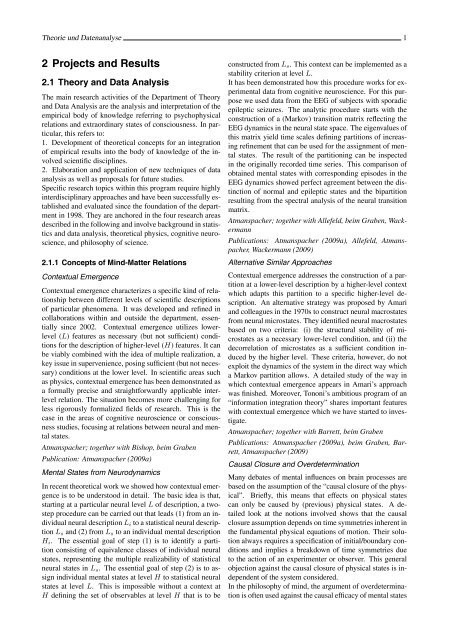
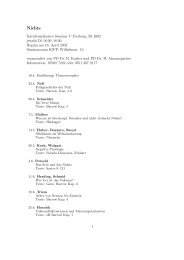
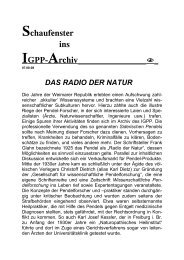
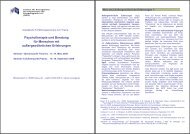
![Findliste Nachträge1 [pdf] - IGPP](https://img.yumpu.com/22552359/1/184x260/findliste-nachtrage1-pdf-igpp.jpg?quality=85)

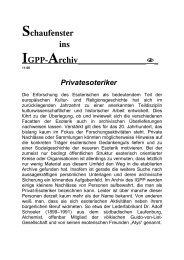
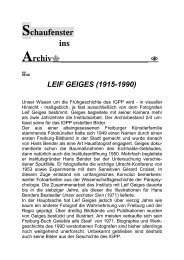
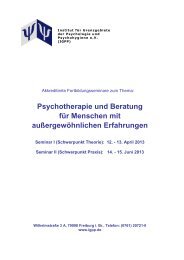
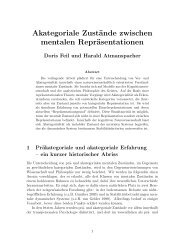
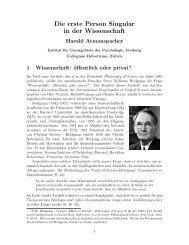
![Findliste [pdf] - IGPP](https://img.yumpu.com/22552265/1/190x245/findliste-pdf-igpp.jpg?quality=85)

